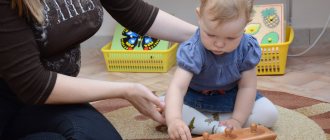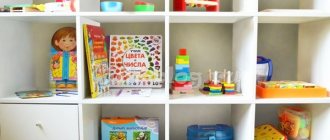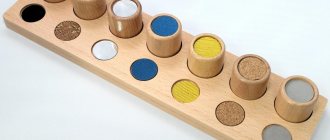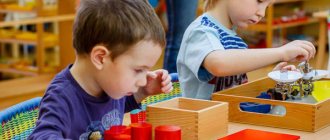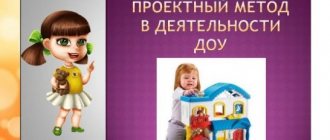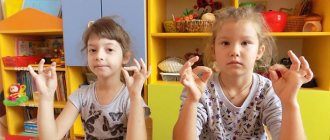What is the essence of the Montessori method?
Montessori education is taught under the motto: “Help me do it myself!” It is believed that if you place a child in a developmental environment and give him freedom of action, he will be happy to explore the world on his own.
Maria Montessori, teacher
Maria Montessori
A child can only reveal himself to us, freely implementing his natural construction plan.
Children choose for themselves what and when to do. The adult’s task is not to interfere, not to criticize, not to praise or compare the child with others. But only show how to use the materials, observe and help if necessary.
Basic Montessori Methods
To briefly outline the main ideas of the Maria Montessori method, it is important to first explain on what beliefs the approach is based:
1. The child develops following his natural interests and thanks to the experience independently gained on their basis,
2. Only a well-organized environment allows a child to fully realize his development potential,
3. An adult can be a guide and assistant, but cannot become the only full-fledged source of knowledge and skills for the development of a child,
It is these beliefs that determine the style of interaction between children and adults who have chosen the Montessori method for their children.
The approach is distinguished by a specially organized environment (didactic material freely accessible to the child), appropriate to the age of the children; the child’s leading position, his independence and free choice of activities; respectful and attentive attitude of adults to the individual needs of the baby.
Let's briefly formulate the basic principles of the Maria Montessori method:
1. Lack of a classroom system and free movement of the child in the classroom space,
2. The absence of a unified program and compulsory curriculum for all pupils, an individual approach to each child,
3. Classes using the M. Montessori method are held in a group of different ages,
4. Any Montessori session requires a prepared environment, ordered and varied materials for learning,
5. The adult follows the child’s interest, observes the children’s work and is very limited in their independent activities.
Now let's study in more detail the features of the Montessori method and start with what goals a Montessori teacher faces depending on the age of the students.
What are sensitive periods
Maria Montessori considered the ages from 0 to 6 years to be the most important in a person's life. She identified six sensitive periods favorable for the formation of certain skills. If you start learning earlier or later, the child will be bored or difficult.
From 0 to 3 years: the period of perception of order
It is easiest to teach a child to be clean and to pick up after themselves before the age of 3. In the Montessori system, order is key. Children are involved in cleaning from an early age; they are shown how to lay out things, wipe off dust, and wash dishes. For work, children are provided with special equipment: comfortable brushes and dustpans, a small mop and a broom.
From 0 to 5.5 years: period of sensory development
The child explores the world around him through sensations, sounds and smells. He develops ideas about shape, color, size.
From 0 to 6 years: period of speech development
Each child’s speech develops individually, and if the baby cannot speak at 2 years old, it’s okay. He still has some time left. And special cards, books and visual materials can help.
From 1 year to 4 years: period of development of movements and actions
The child explores the capabilities of his body, develops coordination and strengthens muscles. To do this, he needs a well-equipped children's playground with slides, swings and wall bars.
From 1.5 to 5.5 years: period of perception of small objects
To develop fine motor skills in the Montessori system, it is suggested to perform the simplest actions: string beads on laces, rearrange beans or peas, assemble puzzles.
From 2.5 to 6 years: period of development of social skills
The child gradually learns to live in society: to say hello, to be polite, to be attentive to the needs of other people, to help.
Montessori material
You may have seen some of the Montessori material already above in the Montessori environment section.
Montessori's didactic material was not created from scratch, partly it is the developments of the “Gifts of Froebel”, already known for 200 years (Froebel is a German teacher, founder of the first kindergarten in 1836), partly it is the methods of Seguin and Itard. Montessori refines their material and also creates his own.
The material is made mainly from wood and other natural materials. Each group is allocated one or two copies of each type of Montessori material, which can cause some indignation in children. Children are not allowed to interfere with another child who is already working with a set, and therefore have to wait for him to become free (but the child usually does not wait, but takes another set). Upon completion of actions with the set, the child must independently fold it and take it to the shelf, only after that the set is available to other children. This is how the Montessori environment develops in children patience, discipline and a sense of the personal boundaries of other people.
The peculiarity of Montessori material is the built-in control function when operating the tool, when the child himself sees his mistakes. This is an important element in this system. For example, a block with cylinders. If the child places the cylinders incorrectly, some will be too deep in the hole, and some will rise above the border level.
The principle of Montessori materials can be partially transferred to many household items at home (but they will not have a control function): jars with lids, boxes, fasteners, clothespins, various gifts of nature (pebbles, sand, acorns), foods (cereals, pasta , beans) and so on. All this is available to the child at home, with the proper approach of the parents.
It is also worth considering that in a Montessori environment, all material is located on open shelves and chests of drawers, no higher than the child’s eye level, so that he can calmly and at any time come up and take it.
How is the development environment organized according to the Montessori method?
In the Montessori system, children are conventionally divided into age categories: from 0 to 3, from 3 to 6, from 6 to 9 and from 9 to 12 years. As a rule, children from 2 years old are involved in classes. And in the group, children of different ages from the same category study at the same time - for example, three-year-olds comprehend the world side by side with five- and six-year-olds. The youngest follow the elders, and the “adults,” by helping others, develop leadership skills and learn to care for the weak.
Rooms in kindergartens and Montessori schools are divided into several zones filled with educational toys, materials and aids.
Sensory education zone
It contains materials for the development of vision, smell, hearing, taste and tactile sensations. Children play with noise instruments, put together figures, touch all kinds of surfaces, get acquainted with smells, and guess what fruit they just ate.
Practical life zone
Children learn basic everyday and social skills: caring for themselves and the environment, etiquette, and rules of communication. They clean clothes and shoes, cook food, water flowers and clean using real tools.
Math zone
Acquaintance with numbers and mathematical operations occurs with the help of toys that develop logic, counting skills, the ability to compare, measure and organize. Gradually, the child goes from basic actions to solving quite complex problems.
Speech development zone
The child expands his vocabulary, develops phonemic awareness, gradually learns to read, and masters writing.
Space Zone (Natural Sciences)
Here the child gets an idea of the world around him: geography, history, botany, zoology, natural sciences.
How to write a term paper on speech therapy
07.09.2010 253370
These guidelines are compiled to help students gain an understanding of the content and structure of coursework in speech therapy.
Logopedia of pedagogical science that studies anomalies of speech development with normal hearing, explores the manifestations, nature and mechanisms of speech disorders, develops the scientific basis for overcoming and preventing them means of special training and education.
The subject of speech therapy as a science is speech disorders and the process of training and education of persons with speech disorders.
The object of study is a person suffering from a speech disorder.
The main task of speech therapy as a science is the study, prevention and elimination of various types of speech disorders.
Coursework in speech therapy is a student's scientific and experimental research. This type of educational activity, provided for by the educational and professional program and curriculum, contributes to the acquisition of skills in working with literature, analyzing and summarizing literary sources in order to determine the range of insufficiently studied problems, determining the content and methods of experimental research, processing skills and qualitative analysis of the results obtained. The need to complete coursework in speech therapy is due to the updating of knowledge concerning the content, organization, principles, methods and techniques of speech therapy work.
As a rule, during their studies, students must write two term papers - theoretical and practical.
The first course work should be devoted to the analysis and synthesis of general and specialized literature on the chosen topic. Based on this analysis, it is necessary to justify and develop a method of ascertaining (diagnostic) experiment.
In the second course work, it is necessary to provide an analysis of the results obtained during the ascertaining experiment, as well as determine the directions and content of speech therapy work, and select adequate methods and techniques of correction.
So, let’s present the general requirements for the content and design of coursework in speech therapy.
The initial and most important stage of working on a course project is the choice of a topic, which is either proposed by the supervisor or chosen by the student independently from a list of topics that are consistent with the areas of scientific research of the department.
Each topic can be modified, considered in different aspects, but taking into account a theoretical and practical approach. Having chosen a topic, the student needs to think through in detail its specific content, areas of work, practical material, etc., which should be reflected both in the formulation of the topic and in the further construction of the study. It should be recalled that the chosen topic may not only have a purely theoretical orientation, for example: “Dysarthria. Characteristics of the defect”, “Classification of dysgraphia”, but also take into account the practical significance of the problem under consideration, for example: “Speech therapy work on speech correction for dysarthria”. It should also be taken into account that when formulating a topic, excessive detail should be avoided, for example: “Formation of prosodic components of speech in preschoolers of the sixth year of life attending a preschool institution for children with severe speech impairments.”
The course work includes such mandatory parts as: introduction, three chapters, conclusion, bibliography and appendix.
The text of the term paper begins with the title page . An example of its design can be seen here.
Then the content of the work is given, in which the names of chapters, paragraphs, and sections are formulated in strict accordance with the content of the thesis. An example of its design can be seen here.
In the text, each subsequent chapter and paragraph begins on a new page. At the end of each chapter, the materials are summarized and conclusions are formulated.
The introduction reveals the relevance of the problem under consideration in general and the topic being studied in particular; the problem, subject, object, and purpose of the study are defined. In accordance with the goal and hypothesis, objectives and a set of research methods aimed at achieving the objectives must be defined.
The relevance of the topic lies in reflecting the current level of pedagogical science and practice, meeting the requirements of novelty and usefulness.
When defining the research problem, it is important to indicate what practical tasks it will help to implement in training and educating people with speech pathology.
The object of research is understood as certain aspects of pedagogical reality, perceived through a system of theoretical and practical knowledge. The ultimate goal of any research is to improve this object.
The subject of research is some part, property, element of an object, i.e. the subject of research always indicates a specific aspect of the object that is to be studied and about which the researcher wants to gain new knowledge. An object is a part of an object.
You can give an example of the formulation of the object, subject and problem of research:
– The object of the study is the speech activity of preschool children with phonetic-phonemic speech disorders.
– The subject of the study is the features of intonation speech of children with phonetic-phonemic speech disorders.
– The research problem is to determine effective directions for speech therapy work on the formation of intonation expressiveness of speech in the system of correctional intervention.
The purpose of the study contributes to the specification of the object being studied. The goal of any research is to solve a specific problem. The goal is specified in tasks taking into account the subject of research.
The research objectives are formulated in a certain sequence, which determines the logic of the research. The research objectives are set on the basis of a theoretical analysis of the problem and an assessment of the state of its solution in practice.
The first chapter is an analysis of literary sources, which examines the state of this problem in historical and modern aspects, and presents the most important theoretical principles that formed the basis of the study.
When writing the first chapter, you should pay attention to the fact that the text of the course work must be written in a scientific style. When presenting scientific material, it is necessary to comply with the following requirements:
– Specificity – a review of only those sources that are necessary to disclose only a given topic or solve only a given problem;
– Clarity – which is characterized by semantic coherence and integrity of individual parts of the text;
– Logicality – which provides for a certain structure of presentation of the material;
– Reasoning – evidence of thoughts (why this and not otherwise);
– Precision of wording, excluding ambiguous interpretation of the authors’ statements.
A literary review of the state of the problem being studied should not be reduced to a consistent presentation of literary sources. It should present a generalized description of the literature: highlight the main directions (currents, concepts, points of view), analyze in detail and evaluate the most fundamental works of representatives of these directions.
When writing a work, the student must correctly use literary materials, make references to the authors and sources from which the results of scientific research are borrowed. Failure to provide required references will reduce your coursework grade.
As a rule, in coursework on speech therapy, references to literary sources are formatted as follows: the number of the cited source in the general list of references is placed in square brackets. For example: General speech underdevelopment is a speech pathology in which there is a persistent lag in the formation of all components of the language system: phonetics, vocabulary and grammar [17].
When using quotations, in square brackets, in addition to indicating the source number, the page number from which this excerpt is taken is indicated, for example: Speech rhythm is based on a physiological and intellectual basis, since, firstly, it is directly related to the rhythm of breathing. Secondly, being an element that performs a communicative function, “correlates with meaning, i.e. controlled intellectually” [23, P.40].
However, course work should not be of a purely abstract nature, so you should not abuse the unreasonable abundance of citations. Quoting should be logically justified, convincing and used only when really necessary.
In the second chapter , devoted to experimental research, the organization should be described and the program of the ascertaining experiment should be presented. The survey methodology, as a rule, consists of a description of several series of tasks, with detailed instructions, visual and lexical material, the procedure for completing tasks by experiment participants, and scoring criteria. This chapter also provides a qualitative and quantitative analysis of the results obtained.
When analyzing the results of an experiment, it is necessary to use a scoring system. Examples of various criteria for quantitative and qualitative assessment are presented in the following works:
– Glukhov V.P. Formation of coherent speech in preschool children with general speech underdevelopment. - M.: Arkti, 2002. - 144 p.
– Fotekova T.A. Test methodology for diagnosing oral speech of primary schoolchildren. - M.: Arkti, 2000. - 56 p.
– Levchenko I.Yu. Pathopsychology: Theory and practice. - M.: Academy, 2000. - 232 p.
In order to visually present the results obtained during the experimental study, it is recommended to use tables, graphs, diagrams, etc. Histograms can be used in a variety of ways - columnar, cylindrical, planar, volumetric, etc. An example of the design of tables, figures, and histograms can be found here.
The third chapter provides a rationale for the proposed methods and techniques and reveals the content of the main stages of correctional work.
The conclusion contains a summary of the material presented and the main conclusions formulated by the author.
The bibliography must contain at least 25 sources. The list includes bibliographic information about the sources used in preparing the work. An example of its design can be seen here.
In the application you can present bulky tables or illustrations, examination protocols, observation records, products of activity (drawings, written works of children), notes from speech therapy classes, etc.
The volume of one course work must be at least 30 pages of typewritten text.
In general, coursework in speech therapy is the basis for a future thesis, in which the study of the begun problem can be continued, but from the standpoint of a different approach or a comparative analysis of the disorders being studied in different age categories of people with different types of speech disorders.
The content and format of theses in speech therapy can be found here.
Literature:
1. How to write a term paper on speech therapy: Methodological recommendations. Educational and methodological manual / Comp. Artemova E.E., Tishina L.A. / Ed. Orlova O.S. – M.: MGOPU, 2008. – 35 p.
2. Research work of students in the system of higher professional pedagogical education (specialty 031800 - Speech therapy). Methodological recommendations for completing the thesis / Compiled by. L.V. Lopatina, V.I. Lipakova, G.G. Golubeva. - St. Petersburg: Publishing house of the Russian State Pedagogical University named after. A. I. Herzen, 2002. - 140 p.
What are the disadvantages of the Montessori system?
Criticism of the Montessori method comes down to the following points.
- In Montessori groups, children communicate little. Although the elders are expected to help the younger ones, this is where the interaction practically ends. Children perform individual tasks and do not play role-playing and outdoor games together. In the future, they may find it difficult to work in a team.
- Not enough attention is paid to creativity. The Montessori system was originally aimed at teaching practical skills. Therefore, creativity, along with games, was perceived as something distracting from the main tasks.
- It is difficult for a child to adapt to the regular education system. In Montessori groups, children are not given standardized grades. The teacher only marks the completion of the task: whether he did it or not. Transitioning to a regular school with grades, reward stickers, and competitive moments can be stressful for your child. And sitting at a desk, doing uninteresting tasks, can be very difficult.
- You will still have to transfer to a regular school. There are only a few Montessori schools in the world with a full cycle of education, up to 18 years of age. In most cases, everything is limited to kindergarten and the elementary level of education - for children 6–12 years old.
Montessori Early Development Methodology
Studying in Montessori classes is structured so that the child acquires knowledge on his own, and the teacher does his best to help him in this. Help does not mean studying textbooks, but offering various types of activities, explanations, answers to questions and a generally friendly attitude.
The Montessori method is based on the fact that while working, the child should be in normal, familiar conditions - let's say, in a natural environment. You should not create some kind of “special atmosphere” in the classroom, as this will be unrealistic. Our task is to teach the child to act in the environment that will surround him throughout his life.
The system offers three types of lessons:
Individual
The essence of the lesson is that the teacher individually selects educational material for the child, which, firstly, will attract the child visually; secondly, it will have a specific appearance, different from everything else that surrounds the child at the moment; and, finally, thirdly, it will allow the child to assess for himself the correctness or incorrectness of his own actions.
If all three conditions are met, then you don’t even have to explain anything to the child - in most cases, children figure out for themselves how to use the educational material. If this does not happen, then no one forbids you to help the child by directing his thoughts in the right direction.
It should be noted that during such classes, all the teacher’s attention should be focused on only one child, others should not interfere.
Group
The algorithm differs little from the previous one. The only difference is that several children who have reached approximately the same level take part in the work.
Are common
All children are involved in the activity. This type of work is not very common, since for general classes it is necessary that all children have approximately the same level of knowledge in the subject, so that someone is not “better” and someone is “worse.” Typically, general classes are held when everyone starts learning a new subject, for example, biology, or at least a new topic that is in no way related to the previous one.
In a Montessori school, classes are based on an age system. The transition to the next grade does not take place over the course of a year, as we are used to, but depending on how the child masters the program. Let us repeat that there are no tight deadlines, so no one can scold a child for not being able to do something. Accordingly, there are no clear goals for the year in such educational institutions. The program is given for three years and the child studies in the way that is convenient for him, because we are all individual, and Montessori understood this.
A Montessori classroom includes a developmental space divided into activity zones. Children independently choose the area and material for work.
The child can work independently or in the company of other children. At the same time, the younger ones help the older ones, and the older ones take care of the younger ones. However, there is an unbreakable rule: if a child is alone in the zone, then no one should disturb him.
Teaching children using the Montessori method requires clear zoning of space. This is done in kindergartens and schools. At the same time, children are not limited in moving between zones. Children gain knowledge through independent activities. Kids don't sit at textbooks. Of course, they have books, and they are used for their intended purpose, but the cramming to which we are accustomed is out of the question.
Pedagogy of Maria Montessori
Larisa Yuzhakova
Pedagogy of Maria Montessori
Maria Montessori
Born on August 31, 1870 in Italy in the city of Chiaravalle.
She was the first female doctor in Italy, psychologist, teacher , and scientist.
In 1896, Maria worked in a children's clinic, and her attention was drawn to the unfortunate mentally retarded children.
Observing their behavior, Maria concluded that every child needs a special developmental environment.
Focused and deeply engaged in psychology and pedagogy , Maria tried to develop her own methods of raising and developing children.
On January 6, 1907, the Children's Home in Rome
pedagogical system was first used .
Since 1909, Montessori's began to spread around the world, and in 1913 they reached Russia. In 1914, the first kindergartens began to open according to the Maria Montessori , but they were closed when the Bolsheviks came to power. Montessori method to our country took place only in 1992.
Based on knowledge of the physiological, mental and psychological development of children, Maria Montessori came to the conclusion that education is a natural process of child development.
Montessori method
Montessori method is a unique author’s system of self-development and self-education for children.
The key attention here is paid to the development of fine motor skills, senses (vision, hearing, taste, smell, touch, as well as nurturing independence in the child.
There are no uniform programs and requirements; each child is provided with an individual pace. Every child is free to do what he likes. So he "competes"
with yourself, gaining self-confidence, as well as fully assimilating the material.
The key principle in Montessori pedagogy is “Help me do it myself.”
. That is, an adult must figure out what the child is interested in, provide him with an appropriate environment for activities and teach the child to use it.
Basic principles of the Montessori
• Child activity. In teaching a child, an adult plays a secondary role, being not a mentor, but an assistant.
• Freedom of action and choice of the child.
• Older children teach younger ones. At the same time, they themselves learn to take care of their younger ones. This is possible because, according to Montessori pedagogy , groups are formed from children of different ages.
• The child makes decisions independently.
• Classes are conducted in a specially prepared environment.
• The adult’s task is to interest the child. Then the baby develops on his own.
• In order for a child to develop fully, it is necessary to provide him with freedom of thinking, action and feelings.
• You should not go against the instructions of nature, you need to follow these instructions, then the child will be himself.
• Criticism is unacceptable, prohibitions are unacceptable.
• The child has the right to make mistakes. He is quite capable of reaching everything on his own.
• The Montessori stimulates in the child the desire to develop his inherent potential, to self-learning and self-education. The responsibility of organizing the children’s activities falls on the shoulders of the teacher, while offering assistance exactly to the extent that is necessary for the child to become interested. The main components of Montessori pedagogy , allowing children to realize their own path of development, are:
• Educator.
• Specially prepared environment.
• Didactic material.
• The role of the adult in the system
• The educator must have wisdom, natural instinct, and experience in order to understand the system. He must carry out serious preparatory work to create a real developmental environment, as well as provide students with effective didactic material.
• Maria Montessori believes that the main task of an adult is to help the child collect, analyze and systematize him (the child)
own knowledge. That is, adults do not convey their own knowledge about the world. It is understood that the teacher must carefully observe the actions of the children, identify their interests, inclinations, and provide tasks of varying degrees of difficulty with the didactic material that the child himself chooses.
• In this case, it is assumed that the adult should be on the same level with the pupil - that is, sitting on the floor or squatting next to him.
• First, he monitors what material the child chooses or helps him become interested.
• Then shows how to cope with the task at hand, while being as laconic as possible.
• After which the child plays independently, he can make mistakes, but at the same time come up with new ways to use the selected material.
• Such creative activity of a child, according to Montessori , allows him to make great discoveries.
• The adult’s task is not to interfere with these discoveries, since even a small remark can confuse the baby and prevent him from further moving in the right direction.
• The role of the developmental environment in the Montessori
• The most important element in Montessori pedagogy is the developmental environment. Without it, the technique cannot exist.
• A properly prepared environment helps the child to develop independently without parental supervision and teaches him to be independent.
• Children have a great need to understand the world around them; they want to smell, touch, and taste everything around them.
• The child’s path to intelligence lies through the senses, so sensation and cognition merge together for him.
• The right environment is one that meets the child's needs.
• The development process of children should not be accelerated, but one must also be very careful to prevent the child from losing interest in a particular activity.
The developmental environment is built according to a strictly defined logic. Traditionally, there are 5 zones:
1. Exercise area in daily life. Here the child learns how to handle his things and how to take care of himself.
2. Native language zone. Allows you to expand your vocabulary, get acquainted with letters, phonetics, and understand the composition and spelling of words.
3. Sensory education zone. Develops the senses, provides the opportunity to study the shape, size, size of objects.
4. Space Zone. Introduces the world around us, the basics of anatomy, botany, zoology, geography, astronomy, and physics.
5. Math zone. Teaches understanding of numbers, order when counting, composition of numbers, as well as basic mathematical operations - addition, subtraction, multiplication and division.
There are no tables in the room, there are only small tables and chairs that can be moved at your discretion, as well as rugs. Children can lay them out where they feel comfortable.
The role of didactic material in the Montessori
A child’s learning is closely related to the subject environment. In this case, almost any objects can act as toys: a basin, water, a tea strainer, napkins, cereals, a spoon or a sponge.
There are also special “ Montessori materials ”
:
“Pink Tower”
, insert molds,
“Brown Staircase”
and others. The manuals were developed with special care and were supposed to carry out a teaching task, as well as contribute to the comprehensive development of students.
Any classes with didactic materials pursue a direct and indirect goal. The direct goal actualizes the child’s movement, the indirect goal develops hearing, vision, and coordination of movements.
An adult or teacher is an observer of the child’s activities. They guide him, patiently wait for the initiative coming from the child.
This is how the baby learns to prevent mistakes. The tutorials are completely accessible to children and encourage them to explore.
Rules for working with didactic material
To encourage the child to take action, the material should be placed at eye level (no higher than 1 meter from the floor)
The material must be handled with care. The material can be used by a child after an adult explains its purpose to the child.
When children work with material, the following sequence should be followed: choosing material, preparing the workplace, performing actions, monitoring, correcting errors, returning the manual to the place upon completion of work with it.
It is prohibited to transfer the manual from hand to hand during group classes.
The material must be laid out in a certain order by the child on a table or rug.
The child can interact with the material not only following the example of the teacher, but also taking into account his own knowledge.
The work should gradually become more difficult.
Having finished the exercises, the child must return the manual to its place, and only after that he can take other materials.
One child works with one material. This allows you to concentrate. If the material that the child has chosen is currently occupied, you should wait while watching a peer’s work, or choose any other.
Maria Montessori notes that these rules do not apply to group games aimed at developing communication and cooperation skills.
the Montessori method
Like any pedagogical system , the Montessori has a number of disadvantages.
The system develops only intelligence and practical skills.
There are no active or role-playing games.
Creativity is denied. It is seen as an obstacle to the child’s mental development (although psychological research suggests the opposite)
.
However, in Montessori gardens there are special playrooms, and the child does not spend all his time in the kindergarten.
This allows us to partially compensate for the last two shortcomings. Montessori system is quite democratic. After it, it can be difficult for children to get used to the discipline of ordinary kindergartens and schools.
Maria Montessori formulated brief commandments and reminders for parents. If you re-read this list at least once a year, your relationship with your children can reach a qualitatively new level, and your child will grow up to be a more developed and harmonious personality:
Children learn from what surrounds them.
If a child is often criticized, he learns to judge.
If a child is often praised, he learns to evaluate.
If a child is shown hostility, he learns to fight.
If you are honest with a child, he learns justice.
If a child is often ridiculed, he learns to be timid.
If a child lives with a sense of security, he learns to believe.
If a child is often shamed, he learns to feel guilty.
If a child is often approved of, he learns to treat himself well.
If adults are often condescending to a child, he learns to be patient.
If a child is often encouraged, he gains self-confidence.
If a child lives in an atmosphere of friendship and feels necessary, he learns to find love in this world.
Don't talk badly about your child - neither in front of him nor without him.
Concentrate on developing the good in the child, so that in the end there will be no room for the bad.
Always listen and respond to a child who speaks to you.
Respect the child who made a mistake and can correct it now or a little later.
Be prepared to help a child who is in search and be invisible to that child who has already found everything.
Help your child master what has not been previously mastered. Do this by filling the world around you with care, restraint, silence and love.
Always use the best manners when dealing with your child - offer him the best that you have in yourself.
Montessori toys
The Montessori system should be introduced to a child in stages (for example, the age from 1 to 3 years is called a Montessori toddler):
For children under one year old it is recommended to use:
- from 1 to 2 months, paper figures, rattle toys in the shape of geometric bodies;
- From 3 months it is recommended to stimulate movement. At this age, experts give preference to wooden figures of bed flowers, hung with special elastic bands. An example could be: a wooden ring or bell that makes a sound with every touch of the baby.
The main toys for a child up to one year old remain objects of everyday life.
Advice to parents : do not interfere with opening and closing drawers, as well as manipulating things not intended for play. It is recommended to store all dangerous and valuable items out of the reach of children. And in one (two) drawers that are accessible to the child’s height, store items from everyday life, with which he will not harm himself when playing.
Advice to parents. The best exercises for children from 1 to 2 years old are in the natural environment. At this age, the child begins to realize that water is perfectly poured into the bucket to the brim. But you can’t pour sand like that. It can be poured. You can start collecting leaves from trees with your child or feeding birds on the street, you can also hang a feeder outside the window.
Toy library for a child from 2 to 3 years old - the main toy at this age is participation in everyday life. Helping parents peel boiled eggs and potatoes (boiled in their jackets), kneading dough, and cleaning.
System history
Maria Montessori was born on August 31, 1870. She was the first female doctor in Italy, as well as a psychologist, teacher, and scientist.
In 1896, Maria worked in a children's clinic, and her attention was drawn to the unfortunate mentally retarded children who, not knowing what to do, wandered aimlessly along the echoing hospital corridors. Observing their behavior, Maria concluded that this is the result of a lack of incentives for development, and that every child needs a special developmental environment in which he can learn something interesting for himself. Focused and deeply engaged in psychology and pedagogy, Maria tried to develop her own methods of raising and developing children.
On January 6, 1907, Maria Montessori opened the “Children's House” in Rome, where the pedagogical system she created was used for the first time. Using trial and error, Maria prepared sensory materials that stimulated children's cognitive interest. Since 1909, Montessori's books began to spread around the world, and in 1913 they reached Russia. In 1914, the first kindergartens began to open according to the Maria Montessori system, but they were closed when the Bolsheviks came to power. The return of the Montessori method to our country took place only in 1992.
Based on knowledge about the characteristics of the physiological, mental and psychological development of children, Maria Montessori came to the conclusion that education is not so much the responsibility of the teacher as a natural process of the child’s development.
Five principles proposed by M. Montessori
- The child is active . The adult acts as an assistant, his role is secondary. The child needs to be interested, and he will develop himself. Classes take place in a specially prepared environment.
- The child is his own teacher . He has full freedom of action and choice. Children teach each other according to the principle from older to younger, which allows them to learn to care for others;
- Child's independence in decision making;
- Full self-development is a consequence of freedom in actions, thinking, and feelings. A child becomes himself when we follow the instructions of nature, and do not go against them.
- Respect for children – absence of prohibitions, criticism and instructions. A child has the right to make mistakes and figure everything out on his own.
In order to understand what the Montessori method is, it is enough to follow its theory and agree with the belief that any child is a normal person, capable of discovering himself in active work
